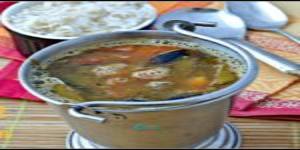
Scope
South Indian meals, particularly lunch, is never complete without some tangy, sour, digestives such as the moru (curd) rice and another soupy dish called rasam. Rasam means “juice”. Rasam commonly refers to soup prepared with sweet-sour stock made from either kokum or tamarind, along with tomato and lentil, added spices and garnish. The Karnataka and Andhra varieties are called saaru in Kannada and chaaru in Telugu, respectively. The spices used include chili pepper, black pepper, cumin etc.
It is eaten with rice or separately as a spicy soup and can be consumed hot or cold. Rasam has a distinct taste in comparison to the sambar due to its own seasoning ingredients. Given its usage as a regular dish in daily meals, Rasam Powder is prepared and stored in airtight containers beforehand.
Fundamental Concepts and Principles
Rasam is prepared mainly with kokum, kadampuli/kachampuli (malabar tamarind) or tamarind stock depending on the region, along with tomato stock. Lentils are optional but are used in several rasams recipes. Other ingredients used are jaggery, garlic, cumin, black pepper, chilli powder, turmeric, curry leaves, coriander as flavoring ingredients and garnish.
The below series covers pretty much the whole gamut of rasams one can savour in South Indian households.
Fundamental Concepts and Principles
Brinjal; ½ padi
Ghee or Oil – ½ palam
Turmeric Powder – ? palam
Tamarind – 3 palam
Salt – 2¼ palam
Roasted Chilli Powder – ? palam
Roasted Coriander Powder – ? palam
Roasted Cumin Seed Powder – ? palam
Roasted Fenugreek Powder – veesam ? palam
Fried Mustard Powder – veesam 1/16 palam
Asafoetida – 2 ku.a
Method
1. Cut the stem of the brinjal before using and fry in ghee till it becomes tender.
2. When the brinjal is cooked, remove from fire. Mix water and tamarind in a vessel that can hold 2 1/2 padi water and that is lead coated. Remove the seeds from the tamarind and extract the juice and boil it.
3. Add salt, roasted red chilli powder, roasted coriander seed powder, roasted cumin seed powder, roasted fenugreek seed powder, roasted mustard seed powder one by one to the boiling tamarind water.
4. You can add 1 and ¼ the palam of the rasam powder prepared instead of these individual powders. Add curry leaves fried in fire to the rasam.
5. Cut the roots of coriander leaves, wash them and add to the rasam and allow the rasam to reduce to ¼ the amount by boiling it. Add the cooked brinjal to the rasam.
6. Heat ghee in a pan and add mustard seeds to it. When the mustard seed stops spluttering, pour it into the rasam.
7. Dissolve asafoetida in water and pour it into the rasam.
8. If the rasam is less than 2 ½ padi water then the salt, tamarind, chilli will be more. If the rasam is vessel full then the salt and chilli will be correct.
Hindu Compliance Body
The Hindu compliance body was established under the executive order of The Supreme Pontiff of Hinduism, dated August 14, 2020, order number 10010, under the title Reviving the Hindu Compliance System and Body
to create, promote, spread and teach the standard procedures for all products and services that are in compliance Hindu Shastras.
Copyright
HCS has the copyright of all its publications. No part of these publications may be reproduced in any form without the prior permission in writing to HCS. This does not preclude the free use, in the course of implementing standard, of necessary details mentioned above. Enquiries related to copyrights to be addressed to KAILASA.
